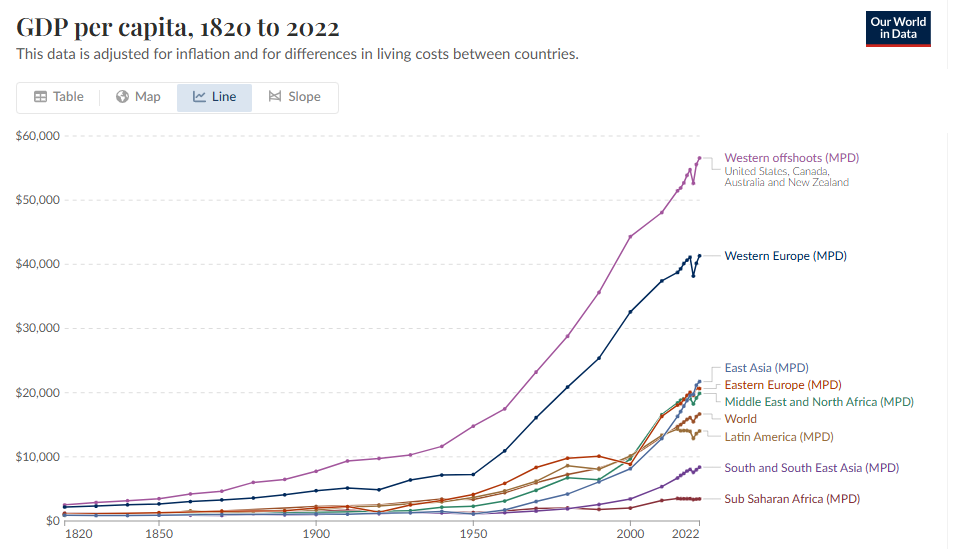Progress is neither automatic nor inevitable. For most of history, living standards remained trapped at subsistence levels until a revolutionary idea emerged 500 years ago: Society could be systematically improved through the acquisition and application of knowledge.
This “Up Wing” formula—embracing knowledge-driven progress despite its disruptive nature—triggered what economists call the Great Acceleration or Great Enrichment. The evidence is compelling in its universal success rate. Take your pick: Britain, China, India, Japan, the United States. Even a bit more economic freedom to create space for Schumpeterian creative destruction works wonders.
The transformation is quantifiable, of course, by metrics such as income, life expectancy, and child mortality.

Before this shift in Europe, existence was “solitary, poor, nasty, brutish, and short.” Also: kind of boring. As historian Benjamin Reiss writes of Europe’s 19th-century peasants in Wild Nights: How Taming Sleep Created Our Restless World:
Many people in cold climates stayed in bed longer in the winter out of necessity. With reduced food supplies and limited sources for heat other than animal skins or other coverings, they simply had to conserve energy. … As late as 1880, one observer said that residents of the Eastern Pyrenees were “as idel as marmots” during the cold months. Entire mountain regions would essentially shut down in late autumn, with some villages essentially “entombing” themselves through the early spring. … An official report in 1844 described what happened to Burgundian day laborers after the harvest season had ended: “After making the necessary repairs to their tools, these vigorous men will now spend their days in bed, packing their bodies tightly together in order to stay warm and to eat less food. They weaken themselves deliberately.
Progress was so imperceptible that philosopher David Hume concluded in 1754 that human capabilities seemed “to have been in all ages pretty much the same.” Today’s prosperity, then, would appear miraculous to our ancestors. As I write in my 2023 book, The Conservative Futurist: How To Create the Sci-Fi World We Were Promised, even the most prescient futurists of 1900 failed to anticipate transformative technologies of the 20th century like nuclear power or the internet. (To wit, Arthur C, Clarke’s aphorism, “Any sufficiently advanced technology is indistinguishable from magic.”)
Progress isn’t something that merely happens—it’s something we choose. Right now, Americans are choosing poorly when it comes to trade, immigration, and, unexpectedly to many, science investment. The Trump administration’s 2026 budget includes sweeping cuts to federal science funding, with the National Institutes of Health (NIH) facing a 40 percent reduction and the National Science Foundation (NSF) losing 55 percent of its budget.
In light of that, this new study from American University’s Institute for Macroeconomic and Policy Analysis is worryingly relevant:
Federal agencies such as NIH and NSF are critical sources of funding for basic and applied scientific research. Recently, many of these agencies have seen their research operations frozen or downsized. This brief describes a new analysis of the macroeconomic costs of cutting federal funding for scientific R&D. The brief finds that budget cuts to public R&D would significantly hurt the economy in the long run, with large negative effects on GDP, investment, and government revenue. A 25 percent cut to public R&D spending would reduce GDP by an amount comparable to the decline in GDP during the Great Recession. Cutting annual public R&D spending in half would make the average American approximately $10,000 poorer (in today’s dollars) than the value implied by the historical trend in GDP. Cutting public R&D would also shrink federal government revenue. A 25 percent cut in R&D would decrease revenue by approximately 4.3 percent annually, while a 50 percent cut would decrease it by 8.6 percent annually.
The post Our Decisions Matter for Technological Progress. Cutting Federal R&D Is a Misguided One appeared first on American Enterprise Institute – AEI.













